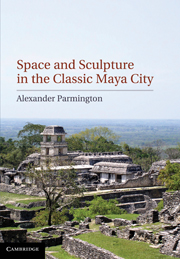Book contents
- Frontmatter
- Contents
- List of illustrations
- List of tables
- Summary
- Acknowledgements
- Introduction
- 1 Defining the Maya built environment
- 2 Investigative considerations and methodology
- 3 Access analysis of the Palenque Cross Group and its sculpture
- 4 Architectural and sculptural programs of the Palenque Palace Group
- 5 Access analysis of the architectural and sculptural programs of the Palenque Palace Group
- 6 Access analysis of Maya art and architecture: Summary and conclusions
- Appendixes 1–7
- Bibliography
- Index
2 - Investigative considerations and methodology
Published online by Cambridge University Press: 05 August 2011
- Frontmatter
- Contents
- List of illustrations
- List of tables
- Summary
- Acknowledgements
- Introduction
- 1 Defining the Maya built environment
- 2 Investigative considerations and methodology
- 3 Access analysis of the Palenque Cross Group and its sculpture
- 4 Architectural and sculptural programs of the Palenque Palace Group
- 5 Access analysis of the architectural and sculptural programs of the Palenque Palace Group
- 6 Access analysis of Maya art and architecture: Summary and conclusions
- Appendixes 1–7
- Bibliography
- Index
Summary
In this investigation, monumental sculpture assigned to private/elite spaces was compared and contrasted with sculpture positioned in public/civic spaces. Monuments and other iconographic media investigated included those that were/are positioned in areas classified as most-public and most-private as well as those that could be positioned along the “privacy gradient” in between (see Chermayeff and Alexander 1965: 121–126; Newman 1972: 9; Rapoport 1977: 290; Lang 1987: 155; Pearson and Richards 1994a: 40; Grahame 1997: 139–142). In my investigation, function and status were ascribed to Maya architecture by interpreting Maya monumental art and its spatial context. It is my proposal that public/civic and private/elite elements are present within sculpture and other media and therefore may be identified and interpreted. Furthermore, I argue that the content, behaviour, and symbolism as displayed in monumental art can be understood as behaviour restricted wholly or partially to these spaces and to certain individuals with status.
A premise underpinning my research was the view that “public space” and “private space” correspond to notions of “common space” and “elite space” in Maya society, where movement between these categories of space can be understood in terms of a gradient of accessibility. It is generally argued that “the demarcation of public/civic and private/elite precincts was … sharply and tangibly controlled by location and scale of features” (Jones et al. 1983: 165).
- Type
- Chapter
- Information
- Space and Sculpture in the Classic Maya City , pp. 20 - 47Publisher: Cambridge University PressPrint publication year: 2011



